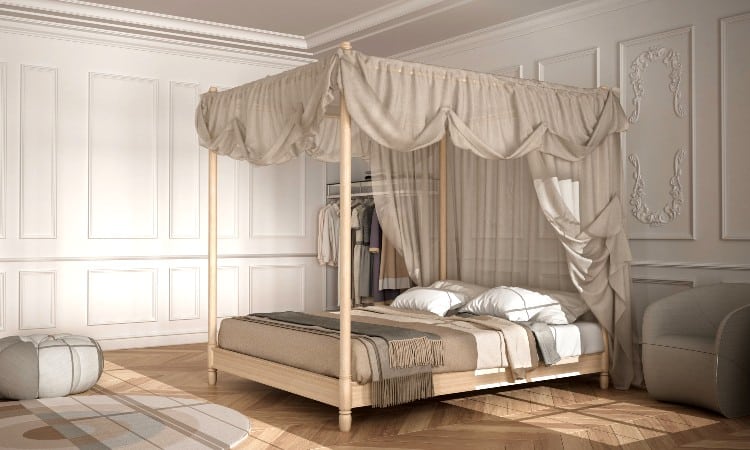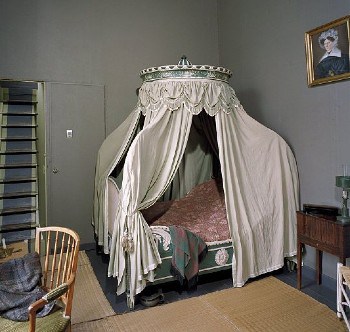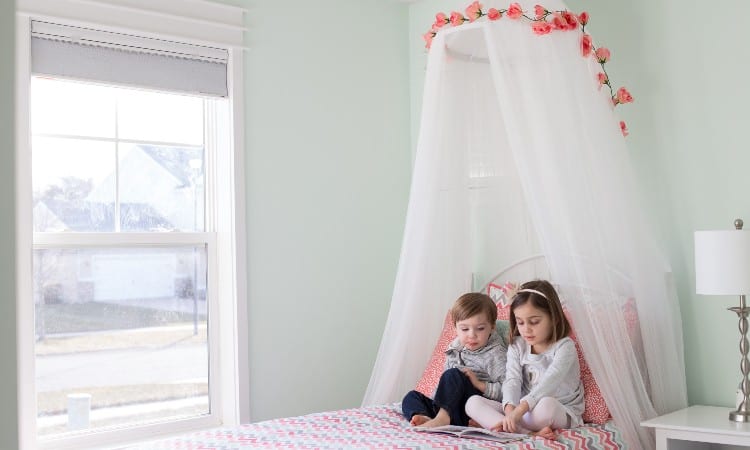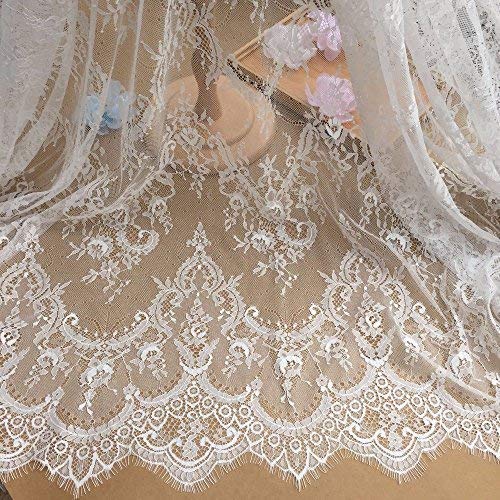Have you ever wanted to add a sense of decadence to your boudoir? If you have, you’ve probably heard about canopy beds. With a range of fabrics available, creating a canopy over your bed is easy. It can add style and sophistication to your room. But what is a canopy, and what is the best fabric for canopy beds?
Canopy beds add a touch of elegance to a bedroom. First used by those of noble birth, they were made from silk, chintz, velvet, and tapestry. Modern-day canopy beds can be made from any fabric. Consider the size of the bed and the style of the canopy to ensure the fabric matches the look you are trying to create.
There’s more to a canopy bed than a four-poster frame. Read on to discover the different styles available. Find out which design will suit your bedroom and which fabric is best for your canopy bed.

What Is a Canopy Bed?
A canopy bed is any bed with an overhead frame that is used to suspend fabric from the ceiling. Think four-poster beds or those cute princess-style beds you can buy for children.
Originally used by the rich, a four-poster bed was a necessity for privacy. Way back in medieval times, when long drafty halls were a thing, the noble classes used curtains around their beds to keep out icy blasts or air. Back then, the drapes would have been heavy fabric, designed to keep out the cold. Castles may have looked impressive, but they were incredibly hard to keep warm!
Curtains also ensured they weren’t spied on as they slept. A distinct disadvantage with castle life was having your noble bed in the same hall as your servants. There’s nothing worse than the feeling of being watched when you’re trying to settle down for the night. For decorum and the sake of a noble’s sanity, a full bed canopy was a must.
Heavy fabrics like velvet and woven tapestries also helped keep unwelcome visitors at bay. Especially the furry four-legged variety. No, I’m not referring to the faithful hunting hounds! A fabric barrier around the bed stopped the castle’s resident rodents from joining the nobles in their slumber.
As building construction improved and better pest control was introduced, the need for heavy brocade fabrics lessened. Softer fabrics like silk, lace, and cotton created the gentle, romantic appeal of the four-poster bed we know today.
These days, a canopy bed can add regal elegance to a bedroom. With a range of styles and sizes to choose from, adding a touch of luxury to an adult’s sleeping space is easily achievable. Offering a focal point to a large space or the illusion of room in a confined area, canopy beds are a great way to make a statement with your décor.
For the kids in your life, a canopy can offer safety. It can create a barrier against all things nocturnal and nasty. A canopy bed can turn a child’s room full of monsters into a dream-like palace of imagination and a fun place to be.
What Types of Canopy Beds Are There?
When it comes to canopy beds, there are several choices. There is a style of canopy bed for every type, size, and style of bed. Just like there are beds for every imaginable bedroom, so too, there is a canopy to fit that room.
This means the chances of you finding the exact match for your room and bed type are high. Let’s take a look at the different canopy beds available and the spaces they are best suited to.
Lit à Colonnes
 The French term lit à Colonnes translates to a four-poster bed. This style is the classic wooden framework we think about when talking about canopy beds.
The French term lit à Colonnes translates to a four-poster bed. This style is the classic wooden framework we think about when talking about canopy beds.
Historically, this style would have been ornately carved wooden posts with a covering of decadent drapes. Modern equivalents are made from decoratively carved or plain wooden posts. Today’s four-poster beds have curtains or cascading fabric. Some have no fabric at all.
The key with this style is the framework matches the size of the bed exactly. The posts are mounted at each corner and support wooden railings that create a box effect around the bed.
Four-poster beds can be anywhere between 6 and 10 feet tall, depending on the design. Make sure you allow for the height of your ceiling if you want a full four-poster bed option.
Lit à la Polonaise

Source: BotMultichillT
Translated into English, lit à la Polonaise is a Polish bed. Thought to have originated in France in the 1700s, this canopy bed is also known as a polonaise. It is possible that the name is down to the resemblance to Polish dress.
This type of canopy bed is a central ring style that sits above the bed. The ring is supported by four posts. These posts are attached to the bed at each corner. However, unlike the four-poster bed, these posts don’t go straight up. They curve towards the central ring. Another key difference to the four-poster bed, the central canopy sits atop of the bed center and doesn’t cover the whole bed.
Fabric is draped from the central ring and cascades down the curved bed posts towards the base. This creates a romantic and more feminine line. As with the four-poster bed, the height on this one can go as high as 10 feet, so make sure you know the height of your ceiling.
Lit à la Duchesse
No products found.Lit à la Duchesse or the Duchess bed is a full-size canopy bed with a difference. The canopy extends out from above the headboard. This style is known as a tester bed. Tester comes from the Latin word for head, which is teste.Unlike the first two beds we looked at, there are no bedposts at the foot of the bed. Meaning the end of the bed is open. Weight from the canopy is distributed across ceiling supports. This was a popular style for aristocratic ladies when it was fashionable to receive guests in their bedrooms at the start of a day. An open-ended canopy bed gave an uninterrupted view of the occupant.
With this style, the fabric is draped from the canopy and tied back towards the headboard when not in use. This creates a box-like frame around the headboard. With less frame available as a focal point, this style is less cluttered. It gives the illusion of a more open and airy space.
Tester beds are a great choice in rooms where a full-frame canopy bed would look out of place. As they don’t rely on posts, height clearance isn’t as much of an issue. They can be suspended from lower ceilings if necessary.
Half-Tester
As the name suggests, the half-tester bed is a smaller version of the full-sized tester or Duchess bed. This style extends out from the head of the bed but doesn’t go as far. A half-tester canopy bed only gives partial coverage. Some canopies cover the head of the bed; some extend a little farther towards the center.
Support for half-tester canopies tends to be a small rectangle frame situated above the headboard. Drapes are hung from the frame and cascade on either side. Depending on how the frame is created, the effect can either be the traditional box style or the more modern, gentle lines of a softer triangle.
This style would suit the smallest of bedrooms. With less frame to worry about, it’s not as heavy as some of the other options available. It can be wall or ceiling mounted at a height that matches the room’s dimensions rather than the size of the frame.
Lit à Couronne
Unlike the previous examples we’ve looked at, which are traditionally rectangular, this one is round. A lit à Couronne is a corona or crown bed because the round frame looks like a crown.
The crown canopy is suspended from the ceiling above the head of the bed. Fabric is hung from the frame and drapes down gently on each side. Due to the roundness of the frame, the result is a softer, flowy triangle shape with less of the rigid structure of the half-tester style.
This style is best suited to smaller rooms and rooms with lower ceilings. Soft, fragile fabrics like lace work well as they add to the subtle delicacy the frame provides. It’s not an overbearing design choice and can be used to great effect to add interest without being pretentious.
Smaller versions of the crown canopy can make a kid’s room pop. With the advantage of being cute in a smaller size, it fits in well with the miniature nature of a child’s bedroom furniture.
What Type of Fabric for Bed Canopy?

The type of fabric you use for your canopy bed will depend on the decorative finish you are looking for. Canopy beds can be made with any material you want. The weave, color, and fiber content will make a difference to your canopy’s overall aesthetics and appearance. So too will the weight of your final fabric choice.
Before you choose a fabric, your first question should be, what style of the canopy are you looking for? To answer that, you need to be aware of the two different weights of material available for your project. Regardless of the fiber content, the two factors you need to consider are whether your fabric is sheer or heavyweight.
Sheer fabric is lightweight and floaty. It’s also transparent. Using a sheer fabric like organza or tulle netting will give your canopy a romantic, airy, almost dreamy effect, especially in creams or subtle shades of yellow.
These fabrics can also generate an image of fairy tales and fantasy, youth, and vibrancy. Couple the transparency with a pastel color like sky blue or baby pink and you have a canopy bed fit for a princess.
Choosing a sheer fabric in a darker color like navy blue or chocolate brown will change the room’s ambiance. Now, you have a hint of mystery.
While still tapping into the feminine side with the sheerness of the fabric, darker colors will raise the game to include some masculine attributes. Now, there’s an element of decadence and more than a little hint of romance giving way to passion.
A heavyweight fabric can give a whole new aspect to a simple four-poster frame. With more weight in the material, you can create volume. Using the luxurious drape of velvet, for instance, can help balance an overly large room. By creating a feature within the space, your bed and the canopy become the focal point, rather than the room’s emptiness.
Heavier fabrics are also better for colder spaces. The weight will create the illusion of warmth. Tie that in with a warm color like red, and you can create a cozy atmosphere in the coolest of temperatures.
When it comes to the type of fabric, the choice is down to you. You can use any fabric you like but make sure it matches what you want it to do. Think about the overall effect you are hoping to create first, then choose the fabric to suit.
What Is the Best Fabric for Canopy Beds?
The best fabric for a canopy bed is the one that gives you a look you were hoping to achieve. Modern canopies can be made from any type of material. Your choice ultimately depends on your room décor, personal preference, and the style of your chosen canopy.
With so many fabrics available and a project that can use any of them, picking one can seem like a daunting task. Let’s take a look at some fabrics more commonly used for canopies. By checking them out side-by-side, you should be able to tell which one will be best for your canopy bed.
1. Lace
 Lace is a delicate fabric synonymous with finery and romance. The floaty, intricate nature of lace makes it an ideal choice for creating an atmosphere of grace, elegance, and enchantment.
Lace is a delicate fabric synonymous with finery and romance. The floaty, intricate nature of lace makes it an ideal choice for creating an atmosphere of grace, elegance, and enchantment.
Better suited to canopies that need smaller amounts of fabric, lace in large quantities can be a bit overwhelming.
Crown and half-tester style canopies are a good choice for this type of fabric.
2. Silk
 Nothing shouts luxurious decadence in quite the same way as silk. It simply oozes sophistication and expense. Silk can be used on any style of the canopy to create elegance and style.
Nothing shouts luxurious decadence in quite the same way as silk. It simply oozes sophistication and expense. Silk can be used on any style of the canopy to create elegance and style.
You may find a full-size canopy with floating drapes a bit pricey if you make it out of pure silk.
A silk alternative like rayon can give the same effect with a cheaper price tag.
3. Velvet
 Traditional fabric for four-poster beds, velvet is a heavy material with excellent drape. It creates a feeling of opulence and indulgence.
Traditional fabric for four-poster beds, velvet is a heavy material with excellent drape. It creates a feeling of opulence and indulgence.
Suitable for any style of the canopy, watch the overall weight with this fabric. Some velvets can be incredibly heavyweight.
This could be a problem if your canopy type relies on being suspended from the ceiling rather than on posts.
4. Chintz
 Chintz is a cotton fabric with an overall floral design. Popular back in the 1980s, chintz is seeing a rise in popularity once more thanks to the cottagecore movement.
Chintz is a cotton fabric with an overall floral design. Popular back in the 1980s, chintz is seeing a rise in popularity once more thanks to the cottagecore movement.
It’s another traditional fabric used for canopy beds that has a modern aesthetic and appeal.
As cotton is available in lightweight and heavier weight weaves, this choice is ideal for any style of canopy. If cottagecore is your thing, this one is right up your street.
5. Tapestry
 The first fabric that comes to mind when you think of four-poster beds is a tapestry. Although not really a fabric, it’s a woven design on a canvas style or upholstery material.
The first fabric that comes to mind when you think of four-poster beds is a tapestry. Although not really a fabric, it’s a woven design on a canvas style or upholstery material.
Because of the nature of the fabric, this one is a heavyweight.
Perfect for full-size canopy beds with the traditional four-poster style, you might find a tapestry design a little heavy for the softer crown or half tester style beds.
6. Muslin
 Incredibly lightweight and airy, muslin fabric is loosely woven cotton that gets softer every time it’s washed.
Incredibly lightweight and airy, muslin fabric is loosely woven cotton that gets softer every time it’s washed.
Slightly translucent and having a nice drape, it’s an ideal material for creating romantic canopy beds.
Muslin can be used for any style of the canopy and can be used as a full covering or gentle, strips of delicate swags. Either way, muslin will give your bedroom a hint of romance.
7. Gingham
 Another cotton fabric, gingham, is a light to medium weight weave well-known for its all-over check design. Available in several colors, gingham is mostly connected to the country living style of décor.
Another cotton fabric, gingham, is a light to medium weight weave well-known for its all-over check design. Available in several colors, gingham is mostly connected to the country living style of décor.
A gingham weave in any color will give your room a sense of rural chic. This one is a popular choice for any canopy but looks particularly impressive when used in the crown style. Embrace your inner cottagecore with the pastel simplicity of gingham.
How Much Fabric Does a Canopy Bed Need?
Your choice of canopy style and the size you want will determine how much fabric you need. The good news is whatever style you choose, the way to calculate your measurements will be the same.
Step 1: Measure the height from your floor to your ceiling and double it. So if your height comes to 70 inches, when you double it, you get 140 inches.
Step 2: Next, measure the width of your bed and add 12 inches to the result. If your bed is 60 inches wide, adding 12 will give you 72 inches.
Step 3: Add your height and width measurements together and then add 36 inches to the total. For this example, that would be 140 + 72 + 36, which equals 248 inches.
Step 4: It’s easier to calculate fabric needs in yards, so we need to convert 248 inches. To do that, divide it by 12 to find out the number of feet. In this case, it’s 20.66 feet. That’s an awkward figure to work with, so round it up to the next whole foot, which would be 21 feet.
To find yards, simply divide 21 by 3 because there are 3 feet in a yard. Our final figure for this example is 7 yards.
This figure doesn’t allow for tiebacks or flounces and ruffles. If you want any embellishments on your canopy, you’ll need to add extra fabric to allow for those. As a rule, it’s always better to estimate higher than you think you’ll need. That way, you have wriggle room for anything you overlooked.
Can Normal Curtains Be Used for Canopy Beds?
Yes. Normal curtains can be used for canopy beds. Hanging them on a bedframe is the same as hanging them from curtain poles. They will behave in the same way.
However, you will need to make sure your canopy frame is strong enough to support the weight of the curtains. This is particularly important if you are thinking about using curtains made from a heavyweight fabric or your canopy is suspended from the ceiling rather than supported by bedposts.
Why Make a Canopy Bed: Pros and Cons
Canopy beds are a design feature that can enhance any bedroom. As with any design choice, there are reasons for and against going down the canopy route. Let’s take a look at the pros and cons so you can make an informed decision on whether a canopy bed will suit you and your lifestyle.
Pros
- Can spice up boring or tired décor
- Creates a focal point
- Romantic
- Can double up as a mosquito net in warmer climates
Cons
- Your chosen style may not fit your room’
- Building a canopy could be expensive
- Time-consuming
- May involve the use of DIY tools like drills
Conclusion
Canopy beds are a great way to add a touch of pizazz to your bedroom. Limited only by your budget and imagination, a canopy above your bed will lift your spirits. Making your sleeping space a magical place to be.
Let me know in the comments if you liked the article. Have you considered making a canopy bed? Has this article helped you choose which style to go for?